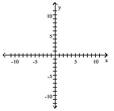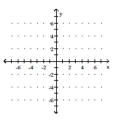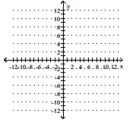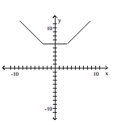A) ![]()
B) ![]()
C) ![]()
D) ![]()
Correct Answer

verified
Correct Answer
verified
Multiple Choice
Graph the equation by plotting points.
-

A) ![]()
B) ![]()
C) ![]()
D) ![]()
Correct Answer

verified
Correct Answer
verified
Multiple Choice
Provide an appropriate response. -If the point (a, b) is in the fourth quadrant, in what quadrant is (-a, -b) ?
A) I
B) II
C) III
D) IV
Correct Answer

verified
Correct Answer
verified
Multiple Choice
Graph the linear function and give the domain and the range. If the function is a constant function, identify it as such.
-

A) ![]()
B) ![]()
C) ![]()
D) ![]()
Correct Answer

verified
Correct Answer
verified
Multiple Choice
Give the domain and range of the relation. -
A) domain: ; range:
B) domain: ; range:
C) domain: ; range:
D) domain: ; range:
Correct Answer

verified
Correct Answer
verified
Multiple Choice
Suppose the point (2, 4) is on the graph of y = f(x) . Find a point on the graph of the given function. -
A)
B)
C)
D)
Correct Answer

verified
Correct Answer
verified
Multiple Choice
Give the domain and range of the relation. -
A) domain: ; range:
B) domain: ; range:
C) domain: ; range:
D) domain: ; range:
Correct Answer

verified
Correct Answer
verified
Multiple Choice
Find the slope of the line satisfying the given conditions. -through and
A)
B)
C)
D)
Correct Answer

verified
Correct Answer
verified
Multiple Choice
Graph the point symmetric to the given point.
-

A) ![]()
B) ![]()
C) ![]()
D) ![]()
Correct Answer

verified
Correct Answer
verified
Multiple Choice
Evaluate the function.
-Find

A) 7
B) None of these
C)
D) 12
Correct Answer

verified
Correct Answer
verified
Multiple Choice
For the points P and Q, find the distance d(P, Q) . -
A)
B) 1759
C)
D) 167
Correct Answer

verified
Correct Answer
verified
Multiple Choice
An equation that defines y as a function of x is given. Rewrite the equation using function notation f(x) . -
A)
B)
C)
D)
Correct Answer

verified
Correct Answer
verified
Multiple Choice
Evaluate the function. -Find when
A)
B)
C)
D)
Correct Answer

verified
Correct Answer
verified
Multiple Choice
Graph the function.
-

A) ![]()
B) ![]()
C) ![]()
D) ![]()
Correct Answer

verified
Correct Answer
verified
Multiple Choice
Write an equation for the line described. Give your answer in slope-intercept form. -through and
A)
B)
C)
D)
Correct Answer

verified
Correct Answer
verified
Multiple Choice
A new chocolate company is estimating how many candy bars per week college students will consume of their line of products. The graph shows the probable number of candy bars students (age 18-22) will consume from year 0 to year 10. B(x) gives the number of candy bars for boys, G(x) gives the number of candy bars for girls, and T(x) gives the total -The radius of a circle of known area is given by , where . Find the radius and circumference of a circle with an area of . (Round results to two decimal places.)
A)
B)
C)
D)
Correct Answer

verified
Correct Answer
verified
Multiple Choice
Give the domain and range of the relation. -
A) domain: ; range:
B) domain: ; range:
C) domain: ; range:
D) domain: ; range:
Correct Answer

verified
Correct Answer
verified
Multiple Choice
The figure below shows the graph of a function y = f(x) . Use this graph to
-

A) ![]()
B) ![]()
C) ![]()
D) ![]()
Correct Answer

verified
Correct Answer
verified
Multiple Choice
Find the average rate of change illustrated in the graph. -An investment is worth $3578 in year 0, the initial investment year. By year 4 its value has increased to $4262. Let y be the value of the investment in the year x. Find and interpret the Average rate of change in value per year.
A) $3578 per year; the value of the investment increases by $3578 per year during these years.
B) $171 per year; the value of the investment increases by $171 per year during these years.
C) $4946 per year; the value of the investment increases by $4946 per year during these years.
D) -$171 per year; the value of the investment decreases by $171 per year during these years.
Correct Answer

verified
Correct Answer
verified
Multiple Choice
Determine the largest open intervals of the domain over which the function is increasing, decreasing, and constant.
-
A) Increasing ; Decreasing ; Constant
B) Increasing ; Decreasing ; Constant
C) Increasing ; Decreasing ; Constant
D) Increasing ; Decreasing ; Constant
Correct Answer

verified
Correct Answer
verified
Showing 201 - 220 of 522
Related Exams